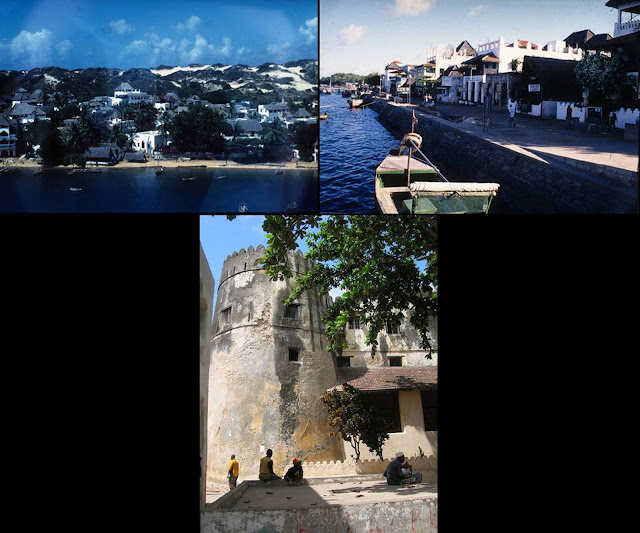Initial Research
To begin with, I asked Fahima some general questions about her painting, to give myself a better idea of how the painting came to be and her own personal opinions on the piece.
Below are my questions, along with the responses from Fahima.
- What is this a painting of?
- The painting is of Fahima's home, Lamu, at sunset.
- Can you describe what is happening in your painting?
- The painting shows many things happening. There are people walking home, going to hotels, there are men rushing to the mosque (the big blue building). The palm trees sway back and forth in the wind. The lights are flickering on as it gets dark. The dog is barking at the woman wearing a black buibui and her child. There is a man riding a donkey, as there are no cars in Lamu. He is beating the donkey on its behind. The sky goes black, as a crescent moon comes out and many stars twinkle up in the sky.
- How does the painting make you feel?
- The painting makes Fahima happy. There are many things that happen in Lamu at night.
- What are your favourite parts of the painting?
- The colourful houses and the sunset are Fahima's favourite parts of the painting, especially the colour of the sky.
Fatima’s responses served as a fantastic jumping off point for my research. I began by investigating the subject of the painting, Fahima’s home, Lamu.
I have been looking at photographs and watching videos of life in Lamu, in the hopes of gaining some perspective on life for Fahima.
Whilst I can only get a glimpse of life in Lamu through my research, the main thing I have come to learn is that Lamu is a place rich with activity.
The days and nights in Lamu are simultaneously dynamic, something that Fahima has demonstrated vividly in her painting.
Lamu at Night
Lamu is also a place of great cultural appreciation, playing host to the Maulidi Festival and the Lamu Cultural Festival, as seen in the video and images below.
The Maulidi Festival and Lamu Cultural Festival
As well as these celebrations of culture, Lamu is also possesses what are considered some of the greatest and best preserved examples of Swahili architecture.
This brief insight into life in Lamu has expanded my understanding and will allow me to approach the animation in a way that is faithful to the subject of the painting.
Inspiration
There is a great deal of whimsy in Fahima’s painting, as well as in her descriptions of her work (“The sky goes black, as a crescent moon comes out and many stars twinkle up in the sky”.) This is something that I am particularly fond of and I aim to draw upon this quality quite heavily throughout the development of the animation.
As a result of this fondness, I have been researching examples that also possess this quality. An artist that fits this bill is Mary Blair, known best for her work with Disney during the 1940s and 50s. I feel Blair and Fahima possess similar, complimentary styles as demonstrated in these examples of Blair’s work. I am still unsure of the narrative that will drive the animation, however when I get to the point where I must interpret particular aspects of Fahima’s painting, Blair’s artwork may provide me with some ideas of how to do this.
I have also been inspired by another, more contemporary artist with connections to Disney.
Daisuke ‘Dice' Tsutsumi previously worked as Art Director for Pixar Animation Studios, dictating the visual style of movies such as Toy Story 3 and Monsters University.
I was drawn to his work, not just because of the whimsy it also possesses, but because of his soft, painterly style. An aspect of Fahima’s painting that I am particularly drawn to is it’s unashamedly painterly appearance. I love being able to see every the impulses behind every brush stroke and paper it lays upon peering through the artwork. However, I was unsure how this could be animated, until I discovered Tsutsumi’s The Dam Keeper.
The Dam Keeper was created by the combining of traditional, two-dimensional painted artwork with technology and CG. Something that is in-keeping with this project, in particular. I feel the film successfully translates painting to film, the same way that Paperman did for drawing.
I think determining some sort of narrative for the piece will be my next objective. Something to move the animation along and prevent it from simply being a slideshow. Fahima’s description of the events taking place in her painting demonstrate a sort of ‘tableau’, reminiscent of the work of L.S. Lowry or even Martin Handford’s Where’s Wally books. This approach may be a good direction to head in, however I want to look into alternative methods that will move the animation off of a single, fixed plane. Possibly moving through some 3D elements, such as the mosque. Most importantly, I need to pay attention to the aspects that Fahima is most fond of, i.e the houses and the sky. In short, I have a lot to consider and I need to determine a way of incorporating as much of it as I can, without over-saturating things.






Really exciting, Steve and I love the input from your artist :)
ReplyDelete